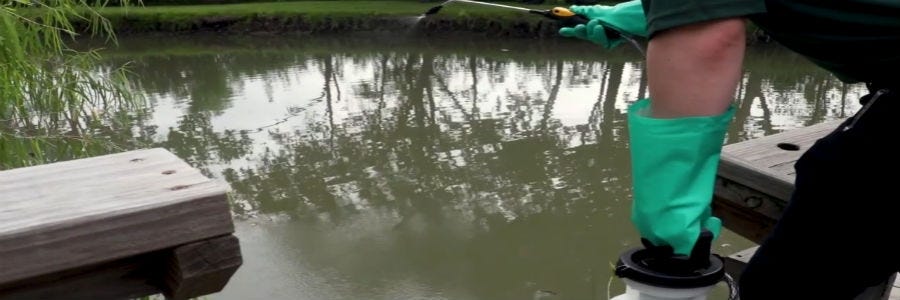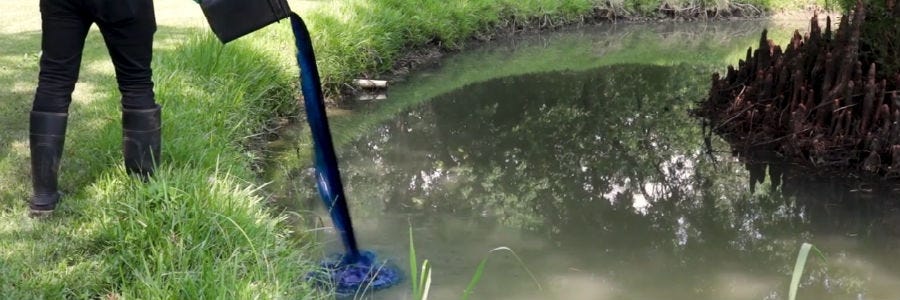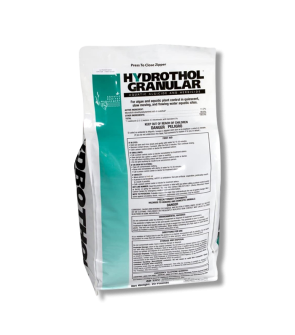Gain access to personalized product screening, the best pricing, rewards, and more!
Most Effective Products
Filamentous Algae Control: How To Get Rid of Filamentous Algae
This page is a general filamentous algae control guide. Using the products and methods suggested, you will get control of filamentous algae. Follow this guide and use the recommended products; we guarantee 100% control of filamentous algae.
Filamentous algae (also known as pond scum) is comprised of a series of cells joined together and resembling little threads that float on the surface of the water. The growth of Filamentous algae often begins at the bottom of a lake or pond and then rises to the surface as oxygen becomes trapped by the filaments. Usually, this type of algae will "disappear" after several days or immediately after rainfall when trapped oxygen is allowed to escape. This "disappearance" lasts for only a short time until oxygen once again becomes trapped.
Filamentous algae are highly noticeable in ponds and lakes and are characterized by bright or dark green hair-like mats that accumulate in the water and float on the pond's surface, resembling wet wool. When nutrient levels rise in the water, algae levels rise, especially in ponds where there isn't much aquatic life to consume the algae. Filamentous algae can grow so plentiful that they can cause a severe shortage of oxygen in the water.
Filamentous algae ruins the look of a water body and discourages recreational activities like swimming. If you have a problem with filamentous algae on your pond or lake, you can eliminate pond scum with the help of our DIY guide below.
Identification

Before proceeding with a treatment program, you must be sure you are dealing with a filamentous algae infestation. Careless identification can lead to using the wrong treatment methods, which can waste time and money. Below are the following characteristics to help you understand what filamentous algae look like.
- There are three main types of algae: pithophora, planktonic and filamentous algae. The way Filamentous Algae is distinguished from the other two algae types is by looking at its structure. Filamentous algae are cells that are joined end-to-end or comprised of long tubes without cell walls. They almost look like a green net of sorts on the surface of the water.
- Filamentous Algae will appear more in clump form and are different pigments of green, from bright to a more dull green. If you feel it may have the texture of a wet cotton ball. Other algae types may be smaller and will give water a green hue but filamentous are more noticeable because of their thick mats.
Use the following description and the corresponding image to help you to identify your algae as filamentous algae. If you need more help, contact us and we will help you to identify the algae you have.
Inspection
 Once you have correctly identified the filamentous algae, you need to inspect it before carrying out any chemical control treatments. You need to see where the coontail is concentrated and how severe an invasion is.
Once you have correctly identified the filamentous algae, you need to inspect it before carrying out any chemical control treatments. You need to see where the coontail is concentrated and how severe an invasion is.
Where To Inspect
Filamentous Algae is obviously algae found on your water body, be it a pond, lake etc. It is important to conduct a careful inspection and analysis of the body of water that will be treated for algae. Take into account the fishes and aquatic life that use the body of water as a habitat as well as the other vegetation in the water that is desirable and vital to the ecosystem before applying chemicals.
What to Look For
Filamentous algae starts growing at the bottom of a water body or on top of rocks or other plants. The individual filaments get tangled, and eventually, they start floating up to the surface of the water. If you have a particularly large amount of algae growth, it should be quite obvious to spot, as it will be in thick clumps on top of the water.
Treatment
Before handling any chemicals, putting on the proper personal protective equipment (PPE) for safety is vital.
Our top recommended product for treating algae is Cutrine Plus Herbicide. Cutrine Plus has demonstrated excellent results in killing Filamentous algae and other algae variants. It is also cost-effective and easy to apply.
Step 1: Apply Herbicide

Cutrine Plus is a copper-based Algaecide and herbicide that is labeled to control Filamentous Algae. It is easy to mix and can be used as a surface spray to kill floating algae. Before mixing, you will need to determine the size of the pond in acre-feet to see how much Cutrine Plus you need to apply.
The label contains a formula to follow to determine the acre-feet (Length (ft) x Width (ft) x Average Depth (ft) / 43,560 = Acre-feet). For typical algae applications, 1 gallon of Cutrine Plus can treat 1.5 acre-feet of water. So for example, if you have a 6-acre pond, you would need 4 gallons of Cutrine Plus.
Dilute the required amount of Cutrine with the right amount of water to ensure an even application is distributed. For small backpack sprayer applications, use a 9:1 dilution ratio (1 gallon of Cutrine Plus to 9 gallons of water) or a 50:1 dilution ratio when using water pump equipment or large tank sprayers. If you have a handheld 1-gallon sprayer, use the same 9 to 1 ratio but for a gallon of water.
In this case, since 1 gallon of water is 128 oz. you would need to divide 128 by 9 to get the amount of Cutrine Plus you need for a 1-gallon treatment, which is 14.2 oz.
The best time to apply is when temperatures are above 60 degrees Fahrenheit. Use a fan spray nozzle to ensure an even coating on the water surface.
Step 2: Follow Up Application
If the pond is heavily infested with filamentous algae, it may be necessary to treat the pond or lake in sections and let each section decompose for about two weeks before treating another section. Aeration, particularly at night, for several days after treatment may help control the oxygen depletion. Algae reproduce rapidly, and it is common not to get season-long control with algaecides.
Prevention
Once filamentous algae have been eliminated from your property, you must implement preventative measures to ensure that it does not return.
- To discourage algae from re-establishing on your pond, we recommend applying Vision Pond Dye. Vision Pond Dye hinders plant development by blocking sunlight into the water and also gives your pond a clean blue color. Measure the appropriate amount of Vision Pond Dye into a bucket based on your pond area measurement findings. The label recommends applying at a rate of 1 quart per 1 surface acre of water at a 5-foot average depth. Pour the pond dye over the edge directly into the body of water and the water's natural movement will disperse the dye.
Key Takeaways
What is Filamentous Algae?
- Filamentous algae are plant cells which form near the bottom of a water body and then float up to the surface, ruining the aesthetics of the pond.
How to Get Rid of Filamentous Algae
- Applications of Cutrine Plus has proven to work best against algae and will kill growths quickly.
Preventing Filamentous Algae Reinfestation
- Applying Vision Pond Dye after a herbicide application works as a great preventative measure that hinders algae growth and improves the look of your pond.









